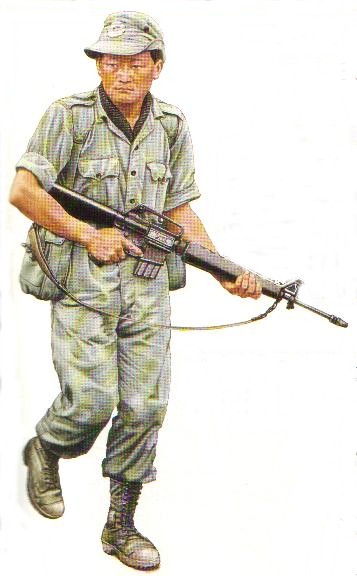GANJU LAMA, who has died aged 75, was awarded a Victoria Cross in Burma for his action on June 12 1944 when B Company, 7th Gurkha Rifles, were checking a Japanese attack, supported by tanks, in the Imphal and Kohima area.
Although the Japanese had failed in their attempt to break through the British lines and move on into India, they still had the resources to mount fierce attacks. On June 12 they had put down an intense artillery barrage on the Gurkha-held position north of the village of Ningthoukhong, knocking out several bunkers and causing heavy casualties.
They followed this up with an exceptionally strong attack. After ferocious hand-to-hand fighting, and supported by three medium tanks, they broke through the line in one place, pinning opposing British troops to the ground with intense fire. B Company, 7th Gurkha Rifles, was ordered to counter-attack and restore the situation. Shortly after passing the starting line, the company came under heavy enemy medium machine-gun and tank machine-gun fire at point-blank range, which covered all lines of approach.
Rifleman Ganju Lama, the No 1 of the PIAT (Projector Infantry Anti-Tank) - which launched a 3 lb grenade on his initiative - crawled forward through thick mud, bleeding profusely, and engaged the tanks single-handedly.
In spite of a broken left wrist and two other wounds, one in his right hand and one in his leg, caused by withering cross-fire concentrated on him, he succeeded in bringing his gun into action within 30 yards of the enemy tanks. He knocked out first one, and then another, the third tank being destroyed by an anti-tank gun.
Despite his serious wounds, he then moved forwards and engaged with grenades the tank crews who were now attempting to escape. Not until he had killed or wounded them all, thus enabling his company to push forward, did he allow himself to be taken back to the Regimental Aid Post to have his wounds dressed.
“Throughout the action,” his citation attested, “Rifleman Ganju Lama, although seriously wounded, showed a complete disregard for his own personal safety and it was solely due to his prompt action and brave conduct that a most critical situation was averted, all positions regained, and heavy casualties inflicted on the enemy.” After this exploit, having been taken by stretcher to the Regimental Aid Post, Ganju Lama was evacuated to a Base Hospital.
His VC - the award of which requires three independent witnesses and the risk of death to be 90 to 100 per cent - was eventually presented to him in Delhi by the Viceroy, Field Marshal Lord Wavell, in the presence of Admiral Lord Louis Mountbatten, General Slim, and members of his own family.
A month earlier, Ganju Lama had been awarded the Military Medal. During operations on the Tiddim Road, his regiment surprised a party of Japanese and killed several of them. Ganju Lama was awarded the MM for destroying two tanks in the action.
After Indian Independence in 1947, Ganju Lama joined the 11th Gorkha (as it is spelt in the Indian army) Rifles, a regiment formed from Gurkhas of the 7th and 10th Gurkha Rifles who had decided to continue their services in India instead of joining the British Army.
Later, he was promoted Subedar Major (Chief Indian Officer in a company of Sepoys) and in 1965 was appointed ADC to the President of India. The year before, a large boil had developed on his leg; when it burst, a Japanese bullet came out.
In retirement, Ganju Lama returned to his people and was appointed honorary ADC to the President of India for life. He had been granted the honorary rank of Captain in 1968 while still serving.
Copyright of Telegraph Group Limited 2000.
Of the Many VC’s won by Gurkhas through the years. I find this one to be the most impressive, This is the Internet account of the action, However in a book entitled “True Courage” (I think) there is a more detailed account;
On arriving back at his Section and under questioning by his superior officer as to why he had gone to such risks as to crawl within thirty yards of the enemy tank rather than engage it from cover, Lama replied,
“I have practiced on the range with the PIAT, and I know I cannot be sure of hitting a target unless I am within 30 yards”
Being aware of your limitations is one thing - but to compensate for them in such a way is surely Valour!

 :evil:
:evil: , that the Gurkhas are mercenaries.
, that the Gurkhas are mercenaries.